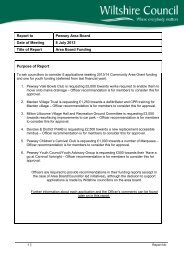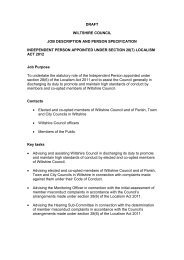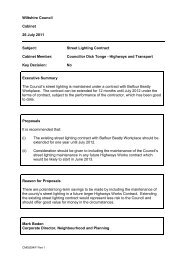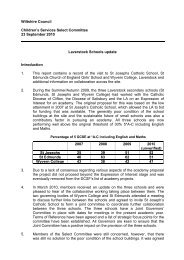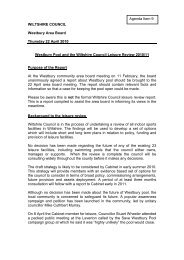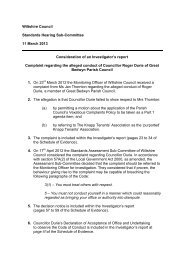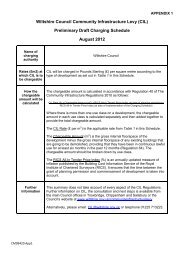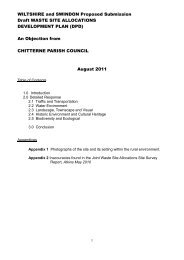6(b) - W1201303FUL , item 76b PDF 84 KB - Wiltshire Council
6(b) - W1201303FUL , item 76b PDF 84 KB - Wiltshire Council
6(b) - W1201303FUL , item 76b PDF 84 KB - Wiltshire Council
You also want an ePaper? Increase the reach of your titles
YUMPU automatically turns print PDFs into web optimized ePapers that Google loves.
REPORT TO THE WESTERN AREA PLANNING<br />
COMMITTEE<br />
Date of Meeting 22.08.2012<br />
Application Number<br />
Site Address<br />
Proposal<br />
W/12/01303/FUL<br />
Church Farm Winsley Bypass Winsley <strong>Wiltshire</strong> BA15 2JH<br />
Partially retrospective application for installation of 104 panel ground<br />
mounted solar array<br />
Applicant<br />
Mr & Mrs Bowles<br />
Town/Parish <strong>Council</strong> Winsley<br />
Electoral Division Winsley And Westwood Unitary Member: Linda Conley<br />
Grid Ref 379741 161156<br />
Type of application<br />
Full Plan<br />
Case Officer Mr Kenny Green 01225 770344 Ext 01225 770251<br />
kenny.green@wiltshire.gov.uk<br />
Reason for the application being considered by Committee<br />
Cllr Rosemary Brown (on behalf of Cllr Conley) has requested that this application be called to<br />
Committee to allow for an open and public debate and to consider the appropriate nature of this<br />
development proposal, including its impact on the Green Belt, ecological and archaeological interests.<br />
1. Purpose of Report<br />
To consider the above application and to recommend that planning permission be granted.<br />
Neighbourhood Responses - None received.<br />
Parish <strong>Council</strong> Response - No consultation response received to date.<br />
2. Report Summary<br />
The main issues to consider are:<br />
Principle of Development / Sustainable Development Objectives<br />
Impact on Ecological and Archaeological Interests<br />
Impact on the Green Belt / Rural Landscape and Surrounding Countryside<br />
Impact on Neighbours / Third Parties<br />
3. Site Description<br />
The application site, located at Church Farm is within the Western <strong>Wiltshire</strong> Green Belt and open<br />
countryside in the Winsley civil parish and amounts to an area of about 470 square metres. The site<br />
is a field that forms part of an agricultural holding centred at Church Farm. The field is relatively flat<br />
and is located to the west of the farm complex, which has in the past, been diversified to include<br />
holiday let accommodation. The field within which the solar array is located is accessed through an<br />
area of land used as a camping and caravanning area. The surrounding field boundaries are formed<br />
by stone walling along with dispersed trees and hedge boundary planting.<br />
The site is identified in the adopted West <strong>Wiltshire</strong> District Plan as having high archaeological<br />
interest/potential.
Apart from the Church Farmhouse, the closest neighbouring residential property is some 180 metres<br />
to the south, separated from the site by agricultural fields, stone walls (which are higher than the solar<br />
array) and treed field boundaries, the Winsley bypass public highway, and residential gardens. There<br />
is a minor access road to the immediate east of the farm complex and a public right of way footpath<br />
(ref. WINS21/10) sited approximately 310 metres to the north east. In both cases, the solar array is<br />
not significantly visible from the public domain.<br />
4. Relevant Planning History<br />
None relevant to this green field site, however the farm complex has been subject to several<br />
applications which have been approved changing the use of agricultural buildings to holiday let<br />
accommodation.<br />
5. Proposal<br />
Under this application, retrospective planning permission is sought for a renewable energy<br />
development comprising the installation of an array of photovoltaic (PV) solar panels to convert<br />
daylight into electricity. The proposed PV panels would potentially generate 30 kwp of electricity,<br />
which will be fed directly into the local power grid.<br />
The array (or solar farm) consists of 104 ground mounted installation comprising panels measuring<br />
1.64 metres long x 0.9 metres wide with a maximum height of 0.44 metres. The panels are fitted into<br />
black basins set out in 6 rows and angled at 25 degrees, "enclosed" by a simple post and wire fence<br />
that is of a height that does not require planning permission.<br />
To convert the direct current (DC) the panels generate, a string inverter is required to turn the DC into<br />
Alternating Current (AC) which can be fed into the national grid. The required inverter is housed<br />
within a timber enclosure measuring 1.3 m (long) x 0.8 m (wide) x 1.2 m (high).<br />
The finished installation involves no pile driving operations as this form of installation negates the<br />
need for significant ground disturbance apart from stripping away the topsoil and running the<br />
underground cabling (which will in due course grass over). When the installation ceases to be<br />
operational or functionally / financially viable, returning the land to its previous condition should be<br />
relatively straight forward.<br />
The ground mounted system is fairly simple with ballast placed into black basins or boxes with the<br />
solar panel simply attached to it and orientated to maximise solar gain. The underground cabling<br />
works had already been undertaken by the time the application had been received by the <strong>Council</strong> in<br />
the middle of July; and by the time the site was visited by the case officer ten days after its<br />
submission, the installation was more or less complete (with a fencer on site preparing to add the wire<br />
fencing around the perimeter of the array).<br />
6. Planning Policy<br />
<strong>Wiltshire</strong> Structure Plan<br />
DP1 - Priorities for Sustainable Development; DP9 - Reuse of Land and Buildings; C1 - Nature<br />
Conservation<br />
C12 - Agriculture; C13 - Land Restoration; RE1- Renewable Energy<br />
West <strong>Wiltshire</strong> District Plan - 1st Alteration<br />
GB1 - Western <strong>Wiltshire</strong> Green Belt; C1 - Countryside Protection; C3 - Special Landscape Area; C15<br />
- Archaeological Assessment; C31a - Design; C32 - Landscape; C34 - Renewable Energy;<br />
The Emerging <strong>Wiltshire</strong> Core Strategy<br />
Strategic Objective 2: Addressing Climate Change<br />
Strategic Objective 5: Protecting and Enhancing the Natural, Historic and Built Environment<br />
Core Policy 42 - Standalone Renewable Energy Installations<br />
Core Policy 50 - Biodiversity and Geodiversity<br />
Core Policy 51 - Landscape
Government Guidance<br />
The National Planning Policy Framework (NPPF - published on 27 March 2012)<br />
The Noise Policy Statement for England (NPSE - published 15 March 2010)<br />
7. Consultations<br />
Winsley Parish <strong>Council</strong> - No comments received. The clerk to the Parish <strong>Council</strong> contacted the case<br />
officer in late July to advise that due to holidays being taken, the next parish council meeting would<br />
not be until early September. However, it is understood that they are now seeking to arrange one<br />
before the meeting of the planning committee on August 22nd. Any views received will be reported to<br />
the planning committee on August 22nd.<br />
<strong>Council</strong>'s Climate Change Team - The proposal should be permitted as it will assist in increasing the<br />
amount of renewable energy generating capacity in the County. This would be consistent with local<br />
and national policy drivers.<br />
A condition requiring the decommissioning of the site and the removal of panels and plant should be<br />
included as part of any permission. However, given that the panels may have a life expectancy longer<br />
than the 25 years of the FIT, this should not be time restrictive or include a specific date. Instead, the<br />
condition should be based on the economic viability of the scheme.<br />
<strong>Council</strong>'s Tree and Landscape Officer - The proposed solar array will have a minimal visual impact<br />
on the surrounding countryside. For this reason there is no landscape or arboricultural reason to<br />
refuse the application.<br />
<strong>Council</strong> Archaeologist - Advice was given to the applicant's agent at the point of submission. The<br />
site is in an area of archaeological interest and, although the known archaeology lies to the north, the<br />
site has potential to include archaeological remains. However, the design and access statement<br />
within the application makes it clear that all ground works associated with the development had taken<br />
place by the time the application was submitted.<br />
This is clearly disappointing, as it runs contrary to the policies in the National Planning Policy<br />
Framework and in addition, it means that there has been no opportunity to assess whether the site did<br />
have significant archaeological remains present. It is appreciated that the ‘scrape’ associated with the<br />
construction may have been more shallow than the previous ploughing, it is nevertheless true that<br />
there is also the potential for damage of archaeological remains by compression within the footprint of<br />
the panels.<br />
However, given that the works have already taken place, further archaeological works would not be<br />
appropriate. However, should the location, size or design of the installation change or should further<br />
ground works be required, the above advice may need to be re-assessed.<br />
<strong>Council</strong>'s Ecologist - No objection raised. The array is sited on agricultural land bordered to the south<br />
by a stone wall. The proposal does not require the removal of any trees or hedgerows. Whilst badgers<br />
are known to be active in the area (records held by the WSBRC) the site does not contain suitable<br />
habitat for a sett. Given the surrounding available habitat, the installation of the array does not result<br />
in a significant loss of badger foraging habitat, so particular fencing measures (i.e. allowing access)<br />
are not required.<br />
The site is located approximately 400 metres north of Winsley Mine SSSI (a component of the Bath &<br />
Bradford on Avon bat SAC, important for its assemblages of hibernating rare species of bat). Solar PV<br />
arrays in the vicinity of a significant roost have the potential to impact upon bat populations where<br />
there is a loss of foraging habitat or an impact to flight lines. However, the application site lacks any<br />
significant vegetation cover that would provide bat foraging/commuting habitat and the plans do not<br />
include any proposed external lighting. Consequently, an impact to the SAC is considered unlikely.<br />
Highways Authority - No highway impacts, therefore no objections raised.<br />
Environment Agency - No objection.
Environmental Health - No objections raised.<br />
8. Publicity<br />
The application was advertised by site notice and neighbour notification. Expiry date: 17 August<br />
2012.<br />
No third party representation has been received to date. If any third parties raise objections before<br />
the committee date, they will be reported to the meeting.<br />
9. Planning Considerations<br />
Principle of Development / Sustainable Development Objectives<br />
The fundamental principle of the planning system is to help achieve sustainable development. Part of<br />
this is to ensure that new development proposals are likely to contribute to this core objective. The<br />
production of renewable sources of energy, on any scale, will inevitably contribute to this objective.<br />
The proposed development at Church Farm is in principle, supported by Structure and District Plan<br />
Policies and adheres with the Emerging <strong>Wiltshire</strong> Core Strategies and Policies. In addition to the<br />
above, material weight must be afforded to the Government's National Planning Policy Framework<br />
which was published and came into immediate effect on 27 March. This publication outlines the<br />
fundamental and over-arching planning objectives, and it is very clear that the NPPF places<br />
significant emphasis upon delivering sustainable development and promoting, supporting and<br />
securing appropriate renewable energy proposals.<br />
This is all reflected in the local plan policy including DP1 of the Structure Plan which states that great<br />
importance needs to be attached to the concept of sustainable development and support new forms<br />
of development which will enable a more sustainable use of resources.<br />
Further to this, Policy C34 of the West <strong>Wiltshire</strong> District Plan 1st Alteration (2004) details that<br />
renewable energy proposals will be permitted in appropriate locations having regard to visual impact,<br />
ecological and archaeological issues, subject to ancillary development; amenity issues; and highway<br />
safety and scale and siting.<br />
Energy usage in the UK (like most developed countries) is at its highest during the day time and early<br />
evening. Whilst residential usage is highest in the evening when people are home, commercial and<br />
industrial energy usage is much higher and the energy demand during the day exceeds that at night.<br />
There is typically a peak in demand during the late afternoon/early evening when businesses/factories<br />
are still operating, but some people are starting to arrive home and begin cook dinner and turn on the<br />
heating. Solar farms naturally only generate electricity during daylight hours, and this coincides with<br />
the periods of highest demand for energy in the UK. The UK currently has the 10th highest emissions<br />
of carbon dioxide in the world, but only the 22nd highest population. The largest contributor to carbon<br />
emissions in the UK is the energy generation sector, through burning of fossil fuels, and this makes<br />
up 40% of the UKs carbon dioxide emissions. The next largest sector is transport, which accounts for<br />
26%.<br />
Locally, <strong>Wiltshire</strong> <strong>Council</strong>’s adopted strategy sets out a clear commitment to increase the uptake of<br />
renewable energy. Action to tackle climate change through energy efficiency and renewable energy<br />
are strong themes in <strong>Wiltshire</strong>’s Community Plan. In the last year, the installation of Solar PV has<br />
increased dramatically raising the County’s position from fifth out of six in the South West to second<br />
only to Cornwall. Whilst each planning application must be considered on its own merits, it cannot be<br />
ignored that <strong>Wiltshire</strong> <strong>Council</strong> is dedicated to addressing the causes of climate change and should<br />
promote, encourage and support (where appropriate) renewable energy proposals; and in so doing,<br />
help contribute to renewable energy and climate change targets, improving air quality (by not relying<br />
on fossil fuels), stimulate the UK renewable industry and employment and improve fuel security and<br />
prices.<br />
It is fully acknowledged that these justifications are proportionately linked to the scale of development.<br />
Government Policy makes it very clear that renewable applications no matter how small should not<br />
be prejudiced because of their relatively small contributions; since every contribution helps. The
NPPF also stresses that sustainable development proposals should go ahead without delay and that<br />
applicants do not have to demonstrate the need for renewable energy developments of any size.<br />
Paragraph 98 of the NPPF further asserts that such applications should be approved if the impacts<br />
are (or can be made through planning conditions and mitigation) acceptable.<br />
It is equally necessary to note that this type of development is, in theory, not permanent; and when<br />
the development comes to an end it would be reasonable to insist on the restoration of the land,<br />
which is recommended by way of a planning condition in this case.<br />
Locally, <strong>Wiltshire</strong> <strong>Council</strong>’s adopted ECO strategy sets out a clear commitment to increase the<br />
uptake of renewable energy. Action to tackle climate change through energy efficiency and<br />
renewable energy are strong themes in <strong>Wiltshire</strong>’s Community Plan.<br />
Impact on the Green Belt / Rural Landscape and Surrounding Countryside<br />
The application site is located within the defined Western <strong>Wiltshire</strong> Green Belt. Policy DP12 of the<br />
<strong>Wiltshire</strong> Structure Plan details that the open character of the green belt should be maintained.<br />
In this particular case, the ground mounted system has a minimal visual impact on the surrounding<br />
countryside. It does not have any adverse impact on the openness of the gren belt and the<br />
countryside due to its very small height and lack of visibility from public rights of way. In these<br />
circumstances, Officers submit that a renewable energy scheme of this nature is appropriate<br />
development within the green belt. In recognising the policy support for appropriately scaled,<br />
designed solar farm installations, the applicant cites the recently approved 5 MW solar farm at<br />
Kingston Farm, located outside of Bradford on Avon and also a smaller solar scheme at Frankleigh<br />
House under W/11/02809/FUL as examples whereby permission has been granted for renewable<br />
energy production, two other sites located within the Western <strong>Wiltshire</strong> Green Belt.<br />
In theory, the development is temporary. When the development comes to an end, whether it occurs<br />
when the use ceases or becomes obsolete, it is considered reasonable to insist on the restoration of<br />
the land through a planning condition.<br />
The type of surface of the solar panels and the angle in relation to the ground are such that there<br />
would be no identified risk of solar dazzle or glare from reflected sunlight or skylight. Furthermore, the<br />
application proposes panels which are designed to be highly absorbent and have an exceptionally low<br />
reflection compared to conventional domestic or toughened glass. This would ensure that the panels<br />
are no brighter than surrounding materials found in the natural environment. The installed ground<br />
mounted system has solar pv panels a maximum of 0.4 metres above ground level, which is<br />
considered low and certainly much lower than the field stone wall boundaries. It is therefore<br />
considered that the proposed should not result in a loss of amenity by way of glare or dazzle to third<br />
parties or users of the public right of way footpath (which is located to north about 300 metres away<br />
from the application site).<br />
The underground trenching of the associated cabling has already been undertaken (and had been<br />
completed even before the application had been formally submitted). The cable run passes through<br />
the field (in which the array sits), through the field gate entry point, through the camping site and leads<br />
to one of the farm steading buildings. Where the ground has been disturbed, it will not take long for<br />
the ground to grass over again.<br />
Impact on Ecological and Archaeological Interests (Heritage Asset)<br />
As noted above, whilst regretting the fact that this application is retrospective, the <strong>Council</strong>'s ecologist<br />
and archaeologist both report no objection.<br />
On the basis of the above, it is submitted that the proposed development would not result in<br />
demonstrable harm to ecological or archaeological interests.
Impact on Neighbours / Third Parties<br />
The development would not be a significant noise generator. The required inverters / switchgear<br />
would be enclosed within modestly scaled timber clad enclosure and there should be no noise audible<br />
beyond the boundary of the site. The solar farm has no moving components and therefore there<br />
would be no vibration impact. The development would have no emissions or waste and it has been<br />
re-affirmed that the proposed PV panels are designed to absorb light for conversion to electricity.<br />
Having highly reflective panels would defeat the whole purpose of a solar farm.<br />
Conclusions<br />
Compared to most solar development currently being brought forward, this is both modest in scale<br />
and small in height. Given the Government and local policy support for renewable energy schemes,<br />
there is no objection to this scheme that has no adverse impact on local amenities or the appearance<br />
of the landscape or its protected Green Belt status.<br />
The fact that the applicant proceeded to complete the works before the application had been<br />
determined, making it retrospective, is to be regretted; but the impacts of the development have been<br />
carefully considered following a robust consultation, which has lead to a positive recommendation.<br />
Recommendation:<br />
Permission<br />
For the following reason(s):<br />
This proposal would make a contribution towards <strong>Wiltshire</strong>’s renewable energy targets, and<br />
the modest scale and low height of the renewable energy installation and the consequent<br />
limited impact on the appearance of the landscape mean that the proposal is acceptable.<br />
Subject to the following condition(s):<br />
1 Within six months of the solar pv ground mounted system ceasing to be used for the generation<br />
of renewable energy, the solar panels and its associated infrastructure, including the scalpings<br />
and the membrane shall be removed from the site and the land restored to seeded grass<br />
agricultural land, in accordance with paragraph 3.20 of the accompanying Design and Access<br />
and Planning Supporting Statement.<br />
REASON: In order to define the terms of this permission.<br />
POLICY: <strong>Wiltshire</strong> Structure Plan 2016 Policies C12 and RE1 and West <strong>Wiltshire</strong> District Plan<br />
1st Alteration (2004) Policies C1 and C34; and the National Planning Policy Framework (NPPF).<br />
2 The development hereby permitted shall not be carried out except in complete accordance with<br />
the details shown on the submitted plans:<br />
LOCATION PLAN received on 11.07.2012<br />
SURVEY SITE PLAN received on 11.07.2012<br />
PROPOSED PHOTOVOLTAIC ARRAY PLAN received on 11.07.2012<br />
REASON: To ensure that the development is carried out in accordance with the approved plans<br />
that have been judged to be acceptable by the local planning authority.<br />
Appendices:<br />
Background Documents<br />
Used in the Preparation of<br />
this Report:



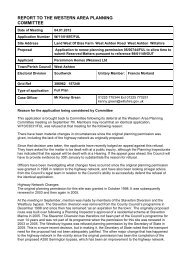

![E100819FUL_AD[1] , item 187. PDF 106 KB - Wiltshire Council](https://img.yumpu.com/25825409/1/184x260/e100819ful-ad1-item-187-pdf-106-kb-wiltshire-council.jpg?quality=85)


